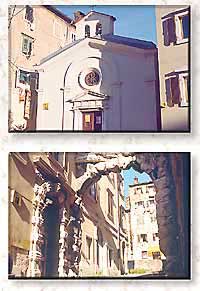9. ST. VITUS CHURCH which stands proud on the square of Grivica was built by the Jesuits and dedicated to Rijeka's patron saint, St. Vitus, who is celebrated every year on the 15th of June. Construction of the church was started in 1638 and continued for an entire century. It's ground plan was innovative for Rijeka, avoiding the familiar three-nave basilical style for a more modern, european architecture based on the model of Santa Maria della Salute in Venice. Altars were initially built in wood, only to be subsequently replaced by marble; the first one in 1717 by Leonardo Paccassi, the seventh and last in 1771. The main altar tells a legend about one Petar Loncaric who, having lost money gambling in front of the church, threw in anger a stone at the cross, whereupon real blood gushed from the body of Jesus. The earth opened up and swallowed the offender, all but his hand which remained protruding and was subsequently publicly burned. 10. ST. SEBASTIAN CHURCH was built as a token of gratitude when the plague of the 13th century ended. It was reconstructed in the 16th century, and in 1806 it received its final preservation works. 11. TOWN GATE This is the oldest architectural specimen found in Rijeka. It was the entrance to the ancient fortress Tarsatica. Archeological research also found traces of old defense walls belonging to Castrum. |
  |
 |
Page 3 of 5 |